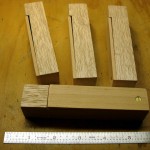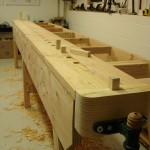 Every respectable woodworking bench has dogs and a vise for clamping work against the dogs. There are several styles of dogs commercially available. Most of them are metal, and I prefer keeping metal as far away from my plane irons as possible. I decided to make, rather than buy, my dogs and settled on 1 inch square dogs made from ramin hardwood square sticks that are readily available at the home center. The spring leaf for each dog is 1/8 inch thick cedar, leftovers from a little resawing project. A notch is cut for the leaf along one side of a dog, and then a cabinet maker’s rasp cuts a short angle at the end. A brass screw attaches the leaf. I borrowed the design from Stephen Sheppard.
Every respectable woodworking bench has dogs and a vise for clamping work against the dogs. There are several styles of dogs commercially available. Most of them are metal, and I prefer keeping metal as far away from my plane irons as possible. I decided to make, rather than buy, my dogs and settled on 1 inch square dogs made from ramin hardwood square sticks that are readily available at the home center. The spring leaf for each dog is 1/8 inch thick cedar, leftovers from a little resawing project. A notch is cut for the leaf along one side of a dog, and then a cabinet maker’s rasp cuts a short angle at the end. A brass screw attaches the leaf. I borrowed the design from Stephen Sheppard.
OK. Next we need holes for the dogs, and a vise. Two boards were use to form the holes, one to hold all 25 dog holes, and the other to close them. Since this bench has a thin top, the depth of the dog holes is doubled by gluing another board below, making the bench twice as thick along the row of dog holes. All holes were hand sawn and chiseled. They are remarkably similar in size.
The vise is a very simple Lee Valley front vise that I’m using as a tail vise. The face block for it holds the moveable dog.
 The usual procedure for building a bench is to glue up the entire top all at once. I have strayed from that path for two reasons. First, I don’t have a reliably flat reference surface 12 feet long that I can use for the glue up. Second, I imagine that the accumulated weight and length would make the complete top heavier than I can manage alone. So, I’m adding a board at a time directly to the bench frame. Attachment is a combination of glue and Miller dowels.
The usual procedure for building a bench is to glue up the entire top all at once. I have strayed from that path for two reasons. First, I don’t have a reliably flat reference surface 12 feet long that I can use for the glue up. Second, I imagine that the accumulated weight and length would make the complete top heavier than I can manage alone. So, I’m adding a board at a time directly to the bench frame. Attachment is a combination of glue and Miller dowels.
There are a lot of rough edges at this point: the top surface of the boards are not even with each other, the boards are slightly over length, and the vise face needs trimming both on the top and on the side that ajoins the apron. All will be resolved when the top is complete. Way down at the other end is a 2 inch by 2 inch planing stop, made of the same ramin as the dogs.
I love this bench!
Simple, clean lines and stable. I cannot see any draw back to the tail vise variation and can see a lot of advantages. I like the curved profile it gives to the end of the table as well.
I really like to see tables made of more common woods. I worry that with too artsy and expensive a wood, you reduce the utility of the bench. When a really hard wood is used, you risk denting the work.
Your workbench makes me want to make another workbench, how to justify a seventh work bench to my wife is going to be the hard part.
Bob
I found your site interesting and beneficial. I hope you will also visit my woodworking blog at http://www.woodworkingtipsandtools.com.
Thanks for the info
I’m curious about how the bench is holding up. I’m building an 8 footer out of southern yellow pine. I am not going to be adding a tool tray to mine either. But, I am concerned about how well the joint from the legs to the aprons will hold up. From the pictures, it looks like you’ve got some screws in the joint to support it. Have you had any issues with the leg to apron joints? Thanks for your input.
Hi Matt,
The bench is holding up really well. There are no screws anywhere in the bench. The leg assemblies are mortise and tenon with draw bored dowel fasteners. The aprons are attached to the legs with miller dowels. No movement whatsoever there. The top is also attached with miller dowels. THAT, I would do differently. The top boards have expanded some and I have a couple of splits. However, they’re not serious. Were I to do it again, I would attach the top with slotted toggles from the bottom to allow for some wood movement.
It’s a very solid bench and from what I’ve seen will probably last decades.
Enjoy building yours!